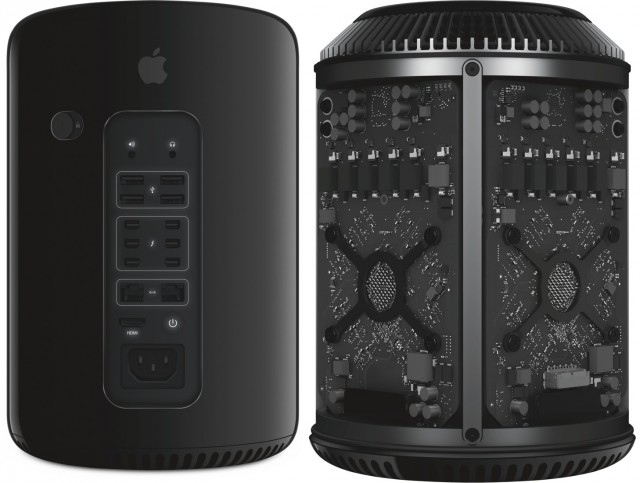It looks like a machine from the future.
It is a machine you’ll only be able to get in the future. And it may be further off before we really see music applications that reach its full potential.
But it does paint a picture of a music machine that’s futuristic, and it isn’t so far off any more.
Apple today made its Mac Pro tower available – sort of. It seems the massively-custom machine is taking some time to ramp up production, as delivery dates quickly slid to February for all but the first to preorder.
But, while the Mac Pro has a hefty price to match its hefty performance, this machine really does look like a monster. For all of the griping from the community, the whole point of the Mac Pro is a move from internal storage and cards to high performance external devices. The core of the Mac Pro is massively powerful, and then you can add accessories via high-performance buses like Thunderbolt 2.
In audio, the main advantage should be mixing performance with mobility. A Mac Pro you can toss in a backpack, but with some of the greatest performance potential anywhere. Internal flash storage delivers lightening-quick load, read, and write times for audio projects of any size, and the six (!) Thunderbolt 2 ports mean potential in low-latency multi-channel audio we haven’t even imagined yet.
The US$2999 “entry-level” model is already a hefty machine, with 3.7GHz Quad-Core Intel Xeon E5 processor and 12GB of 1866MHz DDR3 ECC memory. (Now, admittedly, you’re likely to be happier with the pricing if you’re buying the US-assembled machine in North America; Europe, for instance, does appear to pay an additional premium beyond just VAT at 2.999€.)
If you have a bunch of PCI cards you’re happy with that you want to migrate, then the Mac Pro is a non-starter, it’s true. But if you were building a new studio machine and outboard rig, it’s clear that this is the machine to drool over.
Anyway, I don’t think that the lack of slots is really the issue with the Pro. I think the Mac Pro’s competition will remain other Macs. The problem is, for 90% of the audio projects out there, something like a Mac mini will do just fine. There are even some nice external flash drives for storage that, while falling short of internal drives, still deliver reasonable performance. And even the Mac mini now includes a Thunderbolt port that can work nicely with something like a Universal Audio Apollo multichannel interface, one of a handful of audio devices that now use the throughput for DSP and sound. (That interface performs fairly well even via FW800.)
Of course, once you start doing things like video or intensive graphics, the game changes, so I will take a closer look at the Mac Pro in part on Create Digital Motion.
But I would still expect the Mac Pro to be a powerful choice for the other 10% of users, people who are considering pushing the envelope and investing in a machine that will exceed their performance needs for some time. That’s the feedback we did get from readers, even among others angrily protesting the lack of PCI slots. And while we’ll have to wait a little longer, I think the Mac Pro may make some people very happy, indeed. Expect more criticism, but for the handful of people who do genuinely want a Mac Pro, 2014 is looking like an interesting year.
Photo courtesy Apple.
Update: Universal Audio Compatibility
Speaking of Universal Audio, they’re also the first vendor to talk about compatibility with the new Mac Pros. Because these new Apple computers have a new PCIe architecture, it seems UA’s Thunderbolt devices will require a firmware update for full compatibility, promised for “early 2014.” (Unfortunately, I think I may have a review unit from Apple sooner than that, meaning I’ll have to work out what exactly I can test with.)
Compatible next year: Apollo/Apollo 16 interfaces, UAD-2 Satellites, and the UAD-2 OCTO (once you add a PCI expansion bay to the Octo, that is) “will be fully qualified to work with the new Mac Pros over Thunderbolt via a UA firmware update in early 2014.”
Incompatible: UAD-2 SOLO, DUO, and QUAD PCIe cards – apparently even with the chassis.
This I expect says something about the compatibility picture for other devices, as well.
It’s hard to imagine many audio users being early adopters of the Mac Pro, at least not exclusively. Waiting a while should see more advantages in terms of external audio hardware compatibility; waiting for the next generation could mean picking up the first-generation Mac Pros on the cheap.
